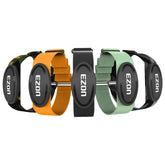Climbing Conquerors: Master the Art of Rock Climbing with These Tips
Rock climbing is a thrilling blend of strength, strategy, and courage, where every hold is a step toward mastering nature’s vertical playground. Whether you’re clipping into your first harness or aiming to send a challenging route, this guide will equip you with climbing techniques, essential safety gear, and strength building strategies to help you climb with confidence and precision.
1. Core Climbing Techniques: Footwork is King
A. Precise Foot Placement
- Edging: Press the edge of your shoe onto small footholds—keep hips close to the wall to reduce arm strain.
- Smearing: Use the rubber of your shoe to stick to featureless surfaces, common on slab climbs.
- Tip: Practice “stepping through” (switching feet without lifting them) to maintain balance on tricky routes.
B. Handhold Mastery
- Jugs: Large, secure holds—use them to rest and plan the next move.
- Crimps: Grip small edges with fingers bent at the first joint; start gently to avoid pulley injuries.
- Pinches: Squeeze holds between thumb and fingers, crucial for slopers and aretes.
C. Body Positioning
- Dynamic Moves: Controlled jumps between holds—focus on hip rotation to generate power.
- Static Climbing: Smooth, controlled movements for delicate balance problems (common in slab climbing).
2. Safety Gear: Non-Negotiable Essentials
**A. Climbing Harness
- Fit Matters: Choose a harness with adjustable leg loops and a padded waistbelt for comfort during multi-pitch climbs.
-
Types:
- Sport Climbing: Lightweight harnesses like the Black Diamond Solution for agility.
- Trad Climbing: Harnesses with multiple gear loops (e.g., Petzl Corax) for carrying cams/nuts.
B. Helmet
- When to Wear: Always on multi-pitch routes or loose rock; optional for indoor climbing but recommended for beginners.
- Certifications: Look for EN 12492 or UIAA standards for impact protection.
C. Other Essentials
- Chalk Bag: Keep hands dry with magnesium chalk—opt for a belt-mounted bag with a brush holder.
- Quickdraws/Ropes: Dynamic ropes for sport climbing (e.g., Edelrid Ohm) and static ropes for top-roping.
3. Strength Building: Train Like a Climber
A. Finger Strength
- Hangboard Training: Start with 10-second hangs on jugs, gradually progressing to smaller holds (3x5 hangs, 60-second rest).
- Grip Diversity: Train open-hand, crimp, and pinch grips to avoid imbalances.
B. Core and Back Strength
- Dead Bugs: Lying on your back, extend opposite arm/leg to improve anti-rotation strength (3x15 reps per side).
- Plank Variations: Side planks and weighted planks to support torso stability on overhangs.
C. Power and Endurance
- Bouldering: Short, powerful routes (V0–V3) to build explosive strength.
- Endurance Laps: 4x10-minute top-rope sessions at 70% max effort to improve sustained grip.
4. Climbing Types: Choose Your Adventure
A. Bouldering
- No Ropes, Just Pads: Focus on problem-solving and dynamic moves—perfect for beginners (start with V0–V2 routes).
- Gear: Crash pad (4–6 inches thick) and climbing shoes with sticky rubber for friction.
B. Sport Climbing
- Pre-Placed Bolts: Clip quickdraws into bolts as you climb; ideal for vertical/overhanging routes.
- Training Tip: Use a sports watch to track climb duration and rest intervals between attempts.
C. Traditional (Trad) Climbing
- Place Your Own Gear: Use cams/nuts in rock cracks—requires route reading and gear placement skills.
5. Common Beginner Mistakes to Avoid
- Overgripping: Relax your hands between holds—tense arms tire faster and reduce precision.
- Ignoring Footwork: Poor foot placement forces over-reliance on arms, leading to early pump (forearm fatigue).
- Skipping Warm-Ups: Do 10 minutes of dynamic stretches (arm circles, hip swings) and easy climbs to avoid injury.
6. Gear Up for Success
A. Climbing Shoes
- Indoor/Moderate Climbs: Versatile shoes like the La Sportiva Tarantula (comfortable for all holds).
- Steep Routes: Aggressive shoes with downturned toes (e.g., Scarpa Instinct) for precise edging.
B. Wearable Tech for Climbers
- EZON Sports Watch: Rugged design with 5ATM water resistance, ideal for tracking climbing sessions and monitoring heart rate during intense routes.
- Activity Tracking: Log climb duration, attempts, and rest periods to analyze progress over time.
7. Mental Toughness: Conquer the Mind, Then the Wall
- Visualization: Study routes from the ground, planning each move before climbing—imagine success to boost confidence.
- Fall Practice: Learn to fall safely (tuck into a ball, land on crash pad) to overcome fear and climb more aggressively.
Ready to Scale New Heights?
Rock climbing is a journey of continuous learning, where every route teaches you something new about strength, strategy, and resilience. By mastering climbing techniques, investing in reliable safety gear like a well-fitted climbing harness, and training both body and mind, you’ll transform from a novice to a confident climber.
Start with indoor gyms to build foundational skills, gradually progressing to outdoor crags as your technique and courage grow. Remember, every hold you grab is a step toward mastery—climb with purpose, respect the rock, and let each ascent be a celebration of your growing strength and skill.









